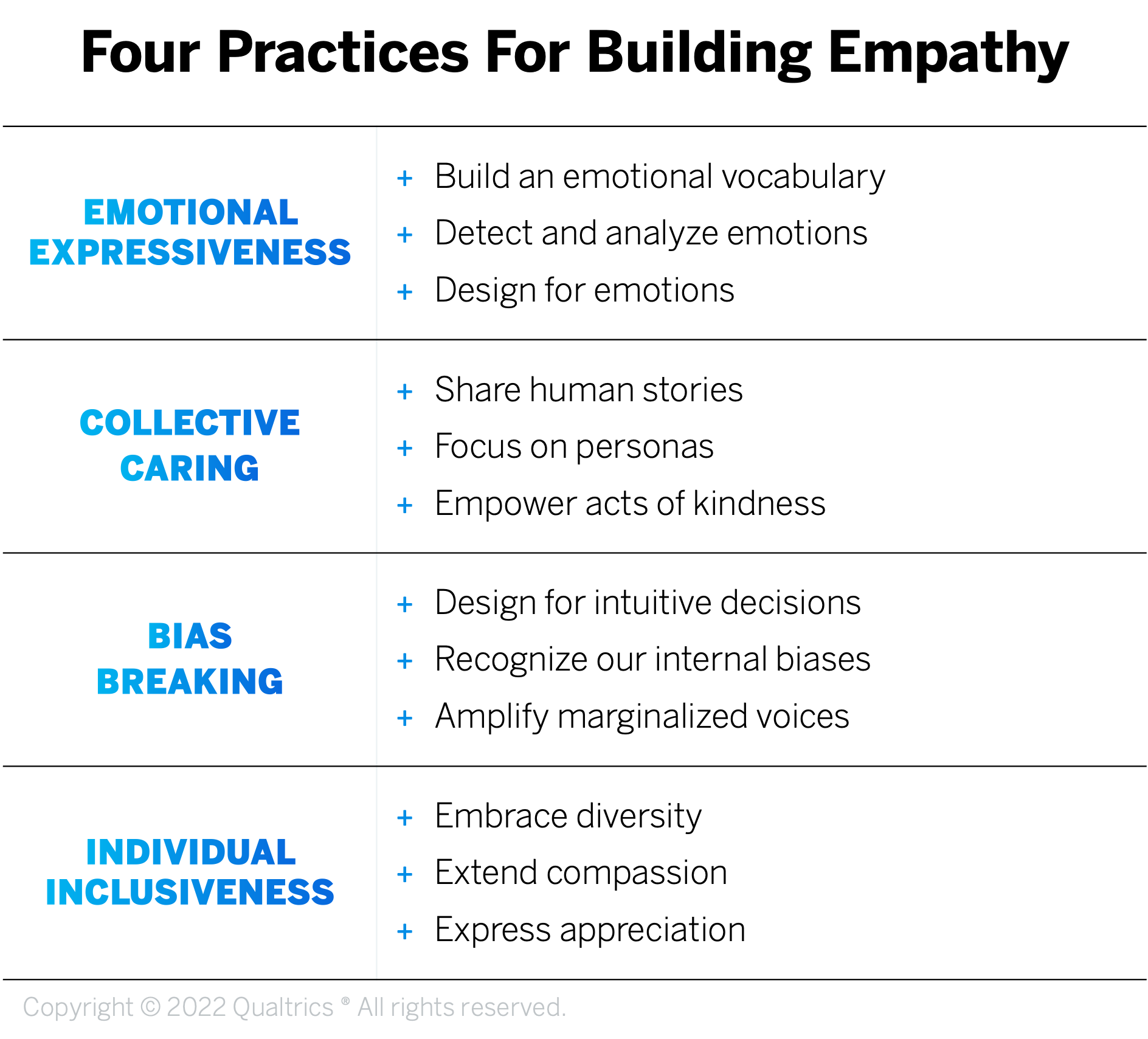Let’s face it, everyone can use more empathy. We need to improve how we collectively treat customers, patients, visitors, members, employees, colleagues, partners, friends, family members, and even strangers.
As we’ve done over the past decade, the XM Institute team is defining a focus for the upcoming year, and we’re labeling 2023, “The Year of Empathy.” We invite you to join us as we explore the topic throughout the year, in hopes that our shared efforts can raise the level of empathy around the world.
Why Did We Choose Empathy?
As we look ahead to 2023, the only thing that is certain for most organizations is ongoing uncertainty. Economic, political, health, and environmental disruptions make it challenging to predict exactly what to plan for or where to head. Strategic and operational priorities may be fuzzy, but one thing is extremely clear: we need to focus more on people. The success of any organization will be based on its ability to better understand and serve the shifting needs of its customers, employees, and communities.
The ongoing uncertainty and its associated challenges have also led to a disturbing rise in unhealthy discord. Instead of coming together to respond to challenges, people have often taken to blaming “other” groups for the problems. By highlighting otherness, we depersonalize our interactions and lose sight of our similarities and shared needs, which far outweigh things that distinguish us from each other.
While all of this can seem like an overwhelming and intractable situation, we believe that the Experience Management (XM) community can make a difference if we apply our human-centric passion, skills, and energy in a focused way.
The Basics Of Empathy
Let’s start at the absolute beginning; what is “empathy?” Merriam-Webster dictionary defines it as:
The ability to imagine oneself in another’s place and understand the other’s feelings, desires, ideas, and actions.
It turns out that there are three types of empathy:
- Cognitive: This is the ability to deliberately consider and perhaps understand the thoughts and feelings of other people. For instance, when we read about people starving in different parts of the world, we can feel pity for them.
- Emotional: This is the ability to vicariously share other people’s thoughts and feelings. Our brains have something called mirror neurons that allow us to virtually feel what someone else is feeling. For instance, if you see your friend bump her head, then you are likely to react almost as if it had happened to you.
- Compassionate: This is the ability to sense what other people need from you. For instance, you recognize that you can help someone lift luggage into the overhead bin on an airplane if they are struggling to do it on their own.
Four Practices For Building Empathy
While most people have an innate ability to be empathetic, organizational dynamics can inhibit that empathy. So we need to develop strategies to not only overcome those obstacles but to amplify empathy from the boardroom to the frontlines. To help infuse empathy into organizational systems and increase empathy around the world, we’ve identified four practices:
- Emotional Expressiveness. Rather than ignoring emotions, make them a normal part of your corporate dialogue.
- Collective Caring. Instead of focusing only on data, examine the thoughts and feelings of individuals.
- Bias Breaking. While humans are selfish and often irrational, we can use that knowledge to adjust what we do to better serve the needs of other people.
- Individual Inclusiveness. As we build empathy in our organizations, we can also focus on our own attitudes and behaviors.

Empathy Practice #1: Emotional Expressiveness
Human beings are driven by their emotions, yet people rarely discuss them and find it hard to articulate their inner feelings even when they try. And it’s even worse in an organizational setting where discussions about emotions can be almost taboo. Instead of avoiding emotions, we need to make them a central topic of our discussions.
Human emotions are immensely complicated and multi-faceted, and they encompass more than just a person’s immediate mental state. Thus, to help you think about emotions in a useful, actionable way, we divide them into two broad categories: stimulation and identification.
- Stimulation refers to how an experience influences a person’s internal state in isolation from anyone else, and it is therefore mostly personal and unaffected by other people. There are two types of emotions in this category: senses and feelings. For instance, if you eat an ice cream cone it may seem very cold (senses) and make you happy (feelings).
- Identification refers to how people orient themselves within and present themselves around other people, and it is therefore mostly external and image-based. There are two types of emotions in this category: social (sense of community and belonging) and values (purpose and meaning). For instance, if you drop an ice cream cone on the ground in front of other people, then you may feel embarrassed (social) and obligated to clean it up (values).
Here are some ways to raise empathy through emotional expressiveness:
- Build an emotional vocabulary. It’s hard to talk about something if you don’t have a common way to describe them. So one of the first things you can do is to establish a set of emotions that you will use in discussions across your organization. For example, we’ve identified five A’s of an emotional response: angry, agitated, ambivalent, appreciative, and adoring. Another example comes from Qualtrics XM Discover (conversational analytics engine), which uses 11 core emotions: love, happiness, sadness, anger, fear & worry, confusion, disgust, surprise, anticipation, embarrassment, and uncertainty.
- Detect and analyze emotions. Every time a person has an interaction, they perceive it through three dimensions: success, effort, and emotion. And guess what? Emotions have the most significant impact on how people remember the experience. So it’s critical that you understand how you are making people feel, including customers, employees, and partners. One of the best ways to do this is to examine people’s emotions during conversations. Using a tool like Qualtrics XM Discover, companies can identify how people feel about their experiences during conversations like contact center calls and social media posts.
- Design for emotions. It’s important to be intentional about the emotions you are hoping to elicit from people. In the XM Institute report, Emotion-Infused Experience Design, we recommend starting the design process by addressing three questions: 1) Who exactly are these people we are interacting with? 2) What is our organizational personality?” and 3) How do we want customers to feel? Neighborhood Health Plan of Rhode Island, for instance, explicitly translates its brand promises (e.g., “Health is our mission”) into specific desired member sentiments (e.g., feeling safe and cared for).
Empathy Practice #2: Collective Caring
Organizations tend to focus heavily on data and processes, which naturally lump individuals into groups to drive numbers and charts. This push for reporting results in structured neglect of individual people’s thoughts and feelings. Any dataset that discusses customers, employees, or partners, is depersonalizing each individual it’s trying to describe. While we aren’t discouraging broad data analysis, here are some ways to augment those efforts to raise empathy through collective caring:
- Share human stories. If your data shows that customers are giving you a 67% satisfaction rating and your employee engagement score is 72%, it may spur cognitive empathy with stakeholders, but it’s probably not enough to drive them to take any action. Instead, to trigger their emotional and compassionate empathy, share stories about specific customers who feel dissatisfied or employees who have become disengaged. So make sure to augment key insights with stories about specific people.
- Focus on personas. To spark empathy across an organization, it’s important to talk about people in a way that all stakeholders can relate to them. One of the most valuable tools to spark this empathy is design personas, which are vivid descriptions of a prototypical person within a specific segment. Personas create a common understanding of that audience within the group of people who are responsible for designing or improving their experiences. As an example, HSBC created four global employee workstyle personas to drive the design of its post-pandemic work experience.
- Empower acts of kindness. While individuals may feel cognitive and emotional empathy, they may not feel as if they have the power to act on their prosocial concerns. This inertia prevents organizations from showing care for the people they interact with. Encourage employees to go above and beyond the tasks that are defined in traditional job descriptions to help other people. Ritz-Carlton, for instance, empowers all employees to spend $2,000 on a customer to quickly resolve a guest issue or to make an experience beautiful and memorable, without a manager’s approval. And you need to ensure that you are celebrating team members who help others to succeed at least as much as those who single-handedly achieve positive results.
Empathy Practice #3: Bias Breaking
We live in a world full of biases, which shape how people think and the decisions that they make. Rather than ignoring them or acting as if they are an unsolvable problem, we need to acknowledge them and factor them into our actions. To build empathy, we particularly need to think about how this causes us to behave in self-centered ways and how it affects the decisions of the people we want to influence.
Human beings are naturally self-centered, as we view the world through our own perspectives, which have been shaped by our unique set of experiences. So our natural empathy may not match the reaction of other people who are quite different. For instance, a 45-year-old marketing executive who grew up in a big city has a very different lens on the world than a 22-year-old cashier from a rural community. Left unchecked, we will make decisions that satisfy our personal needs, instead of those that satisfy the needs of the target customers, employees, or partners that we are trying to serve.
As we think of the customer, employees, and partners, we want to influence, we need to understand how they make decisions. Companies often design experiences as if people were perfectly rational robots, but human beings aren’t like that. While they sometimes use Rational Thinking, which relies on logic and reason to make decisions, people more frequently use Intuitive Thinking, which relies on cognitive biases and mental shortcuts to make decisions. Rather than supporting peoples’ unconscious decision rules like preferring to maintain the status quo, companies create experiences that slow down their progress, or even derail them completely.
Here are some ways to raise empathy through bias breaking:
- Design for intuitive decisions. Rather than trying to push people to do something, consider tapping into their biases to nudge, assist, or enhance their experiences. For instance, when a ride-sharing service wanted to encourage more drivers to work on a certain day, it found that showing them how much money they lost by not working on that day was more effective than showing them how much money they could potentially make. That shouldn’t be a surprise given human beings’ loss aversion bias. We’ve identified six categories of heuristics and biases that you should factor into your efforts; people: 1) Are more affected by losses than by gains; 2) Prefer simplicity over complexity; 3) Are affected by current emotional and visceral states; 4) Are heavily influenced by those around them; 5) Make decisions based on context; and 6) Misjudge their past and future experiences.
- Recognize our internal biases. Being self-centered or preferring simplicity isn’t a problem, it’s a reality that should be acknowledged. You need to develop approaches that will keep those biases from negatively affecting your organization’s decisions and actions. For instance, because decision-makers will naturally empathize with the people who are most like them, whenever a group is making a decision that affects people’s experiences, it should explicitly identify the segment(s) it understands the least and then test its underlying assumptions with real people from that segment. Decision-makers should focus more on the personas that look the most different from the decision-makers since they will naturally empathize with the ones that look like them.
- Amplify marginalized voices. There are many variations in the way people can experience the exact same moments – some will be more positive than others. But our understanding of the experiences across different groups of people often gets lost because they are lumped together as majority segments dominate the data. This can unintentionally create systemic problems if the same groups of people are consistently left out or repeatedly excluded. So it’s important that we uncover and close experience gaps between majority and underrepresented groups. These gaps often show up in core measurements such as interaction channel satisfaction, customer relationship measures like Net Promoter Score, and employee measures such as engagement scores.
Empathy Practice #4: Individual Inclusiveness
While there are many things that you can do to raise empathy across your organization, you can also focus on a more intimate topic, your personal thoughts and actions. By behaving empathetically toward all of the people you interact with, you will not only positively affect all of those people, but you will also be modeling behaviors that others will adopt. So what can you do? In 2018, when we focused on the theme of humanity, we introduced these three behaviors:
- Embrace diversity. Human beings are complicated in so many ways, which makes each of us a rare, wonderful specimen. Rather than mentally categorizing people into larger groups, look for the positive, unique elements of every person that you come into contact with. This will allow you to find interesting, common ground with people who may appear to be quite different than you. This also applies to people who have differing points of view on important topics. One of the keys to success here is to always assume that the person you are interacting with has positive intent, meaning they (like you) are just sharing their honest perspective.
- Extend compassion. There are so many people in need around the world, from those who are suffering from visible issues like hunger or physical restrictions to those who may be struggling with hidden challenges like anxiety or neurodiversity. So it’s important that you tune into the condition of the people around you and proactively think about how you can improve their well-being. But you can’t only care about other people. It’s critical to start by showing compassion for yourself as well. Make sure that you are well-attuned to and taking care of your own well-being. It’s very hard to extend compassion if you are burnt out or suffering.
- Express appreciation. During changing and uncertain times, it’s easy to feel overwhelmed and beaten down. Gratitude is like a wonder drug to help break that malaise and energize positive feelings. Research shows that people who are grateful have stronger immune systems, less stress, feel less pain, and do better professionally and academically — to name just a handful of the benefits. Set aside time on a regular basis (daily or weekly) to express your thanks to colleagues, friends, and family.
Join Us In Making This The Year Of Empathy
Hopefully, we’ve inspired you to join us in raising empathy around the world in 2023 and provided you with some ideas about how to participate in this global initiative. Here are some initial steps that you can take:
- Share this blog and promote the idea of making 2023 the Year of Empathy across your organization.
- Hold a brainstorming session with your XM team to identify ways that your efforts can be shifted to better increase empathy across your organization.
- Work with different teams across your organization to identify how XM can help them increase empathy in their efforts.
- Keep an eye on the XM Institute site as we will be publishing more content on empathy, and join the XM Pros community to engage in discussions about XM and empathy with your peers and the XM Institute faculty.
The bottom line: We can collectively increase empathy around the world.
Bruce Temkin, CCXP, XMP is the Head of Qualtrics XM Institute
Dr. Cecelia Herbert, XMP, PsyD, is a Principal Catalyst for Qualtrics XM Institute
Isabelle Zdatny, XMP, CCXP, is an XM Catalyst with the Qualtrics XM Institute





